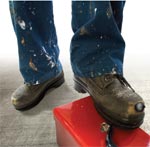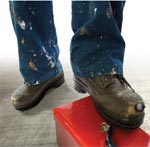
Back to the Basics
Everyday incidents bring home the real need for explaining the fundamentals of occupational foot protection.
 His safety toe work shoes were so caked with
layers of sticky, thick, red mud, inside and
out, that I doubted he could ever get them
clean again. I watched this landscaper cram
his feet into wet muddy socks and back into the same
mud-caked shoes. It was only 7 a.m. that morning, so it
would be a long day with painful results for this worker
who was doing tasks ranging from using mowing equipment
to setting a retaining wall on a construction site. I
asked the job supervisor, who shrugged and answered,
“He’s new. He’ll learn.”
His safety toe work shoes were so caked with
layers of sticky, thick, red mud, inside and
out, that I doubted he could ever get them
clean again. I watched this landscaper cram
his feet into wet muddy socks and back into the same
mud-caked shoes. It was only 7 a.m. that morning, so it
would be a long day with painful results for this worker
who was doing tasks ranging from using mowing equipment
to setting a retaining wall on a construction site. I
asked the job supervisor, who shrugged and answered,
“He’s new. He’ll learn.”
Those of us who wear foot protection on the job
know the consequence of not taking care of our shoes
is losing both our comfort and our ability to work safely.
In truth, those of us who wear protective shoes or
boots have at one time or another worn them wet,damaged,
or soiled/contaminated in some manner. We
learned, one hopes, without injury or incident. Even
being safety professionals, we get in a hurry and forget
or disregard the rules, just like all other employees.
But we do learn from mistakes and, because we have
made them, can assist others to work more safely and
comfortably. This is not a “do as I say, not as I do,” but
more of a “hey, there is a better way—let me show you.”
So the muddy-shoe time of year is here once more.
I see a lot of construction workers, landscapers, and
other outside workers wearing occupational foot protection
that has been abused.When I do, I always wonder
whether anyone has ever explained to them how to
care for work shoes and boots.You know what I mean:
the simple things, such as keeping the footwear clean
and in good repair.Allowing it to dry completely before
wearing.And socks? Does anyone explain the injury potential
of wearing wet socks all day or the blisters and
other injuries, such as fungus, that can occur? Has anyone
addressed first aid for these problems?
If this information has been delivered, what happened?
Why do employees, new and seasoned alike,
not take care of one of the most important pieces of
safety equipment?
Root Causes
Carelessness. Many employees do not consider their
foot protection until either an accident occurs or their
feet begin to hurt.
Ignorance. Some employees do not understand how
to care for work boots or how to clean shoes properly
using the correct method and materials. Gasoline, for
example, is not an all-purpose solvent for cleaning work
boots, but we still see it used in some cultures.
Fear. Employees may be afraid to ask questions or
fear teasing from others when asking for help. Education
has to be offered to everyone in order to capture
this group. Some will not admit to pain or having any
problems until the situation is serious, in order to be invisible
at the workplace.
Supervision. Make sure your supervisors take foot
protection seriously and follow up on problem areas,
such as employees not wearing appropriate foot protection,
wearing it incorrectly, or failing to keep it clean.
Education. Have your employees been educated on
what to wear and how to select the correct foot protection
for the job? Can they ask questions without a
group around?
Explain to your employees what the real need is for
occupational foot protection. It is more than policy and code compliance. Evaluate the real hazards,
whatever they may be, at your workplace
and help to protect and guide your
employees to protect themselves from the
common and not-so-common injuries.
Many employees do not fully understand
the job dangers, and it is part of the supervisor’s
role to educate them.
Real-World Hazard Evaluation
Only in a perfect world do all employees do
the same tasks, day in and day out.Most employees
will offer or be asked to take on different
tasks from time to time, and this may
change their need for foot protection.When
the hazard changes, the footwear should improve
to meet the hazard.
Even when employees volunteer their
services (such as during a crisis situation),
they must be outfitted correctly for the job.
From restaurant workers dealing with grease
on the floor near a frying station to health
care employees needing quality construction
and ease of sanitation, to a foundry worker
or a painter working with electrostatic spraying,
footwear for the hazard exists and is
available. Employees need to be aware of
what they need and when they need it.
Many employees disregard hazard potential
at their workplace, thinking an injury
will never happen to them.More than
once, I have seen workers wearing tennis
shoes working with rollers on terrazzo
flooring, completely oblivious to the danger.
You’ll see movers of heavy equipment
wearing only leather shoes without safety
toes.Are your employees aware of and paying
attention to the danger of falling objects,
slips and falls, etc.? What about unique
hazards? Are these tasks evaluated on a regular
basis in case the jobs are becoming
more hazardous?
For many years, blame was a part of any
safety program. If an employee did not wear
the correct shoes on site, for example, he was
blamed and suffered the consequences accordingly.
Now, with better management
and an understanding of which methods really
work, blame is being replaced (slowly)
with reinforced education that is provided
prior to exposure to the hazard and reinforced
regularly through reminders,supervisor
interaction, and reviews. It is a system
that takes time to be successful, but given
time and energy and concern, it does work.
We can no longer assume workers understand
the hazards of their jobs or how to
select and care for PPE, such as foot protection.
No longer only using skilled tradesmen,
we now have workplaces filled with inexperienced
newcomers, experienced workers,
temporary staffers, and those who have promoted
up the ranks and may not have been
educated in the selection and care of foot
protection. Make sure your supervisors are
working toward your goals, too.
Waiting until after the accident is too little,
too late. Educate and mentor your workforce
by answering their questions about
common problems. The results will usually
show on your injury logs with fewer or lesssevere
injuries.
This article originally appeared in the September 2008 issue of Occupational Health & Safety.